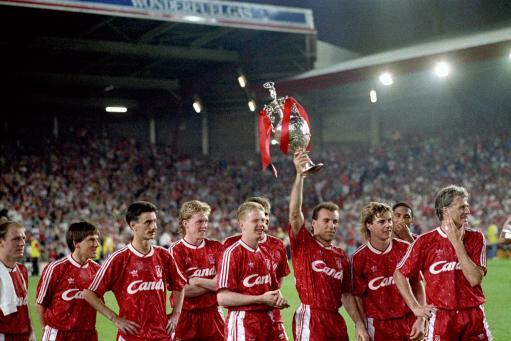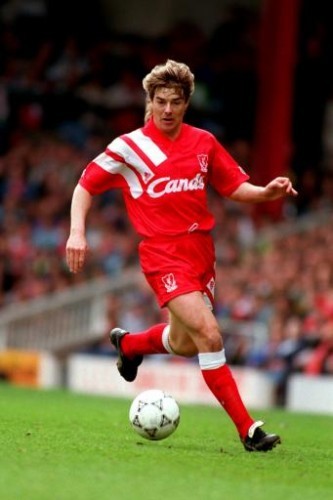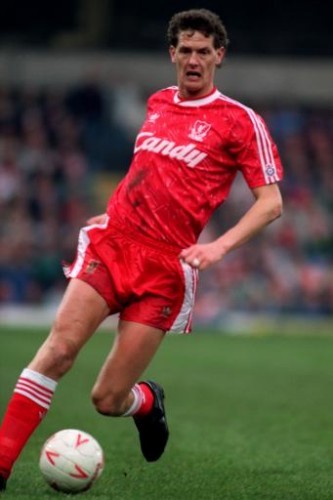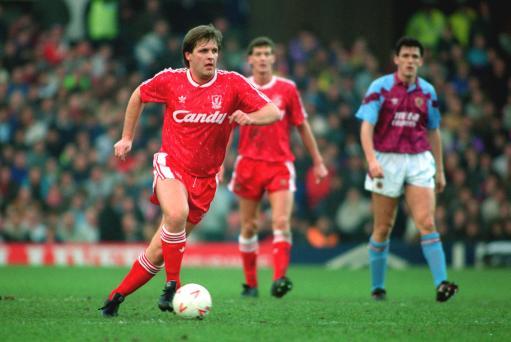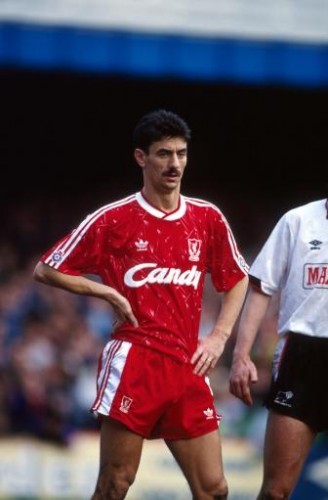TWENTY-FOUR YEARS ago, Liverpool clinched the First Division title with two games to spare. At Anfield, in front of 37,758, Kenny Dalglish’s side came from behind to beat Queens Park Rangers 2-1. Fittingly, the goals came courtesy of John Barnes and Ian Rush – between them they scored thirty-nine times (50% of Liverpool’s overall total) and it was their clinical performances that pushed the club to a 18th championship.
Others more than played their part. Peter Beardsley chipped in with ten. The Israeli international Ronny Rosenthal, signed in March 1990 on loan from Standard Liege, grabbed a hat-trick on his debut and added four more goals before season’s end. Elsewhere, Alan Hansen and Steve McMahon, along with Barnes and Beardsley, were named to the 1989/1990 PFA Team of the Year.
A few weeks later, Liverpool beat Derby at Anfield and were presented with the trophy after the game.
Ever since though, it’s been a well-documented barren run for the Merseysiders. So, whatever happened to the group of players that claimed the club’s last ever league title?
GOALKEEPER: Bruce Grobbelaar
In a thirteen-year career at the club, the eccentric shot-stopper racked up thirteen trophies but his on-pitch success only tells a tiny part of the story. Even before he arrived at Liverpool, his background was strikingly different from the typical footballer’s story. Born in Durban, he moved to Rhodesia when he was two. Having joined the army in 1975, he subsequently fought in the Bush War. His football career was in the ascent though and after impressing in South Africa, he was signed by Vancouver Whitecaps before a successful loan move to Crewe. He was brought to Liverpool by Bob Paisley in 1981. He’s still best-remembered for his ‘spaghetti legs’ routine during the 1984 European Cup penalty shootout against Roma.
In 1994, Grobbelaar left Anfield and moved to Southampton. Later that year, his business partner Chris Vincent told The Sun that the goalkeeper was involved in match-fixing. In a bugged hotel room, Grobbelaar told of how he had received £40,000 for throwing a Liverpool v Newcastle game in 1993 and was caught on camera accepting £2,000 as a down-payment for throwing more matches.
In 1997, Grobbelaar was in court, pleading his innocence. The jury failed to reach a verdict but after a retrial, he was acquitted. Two years later, he successfully sued The Sun for libel but following an appeal, Grobbelaar was forced to pay the newspaper’s legal costs of £500,000. He couldn’t and was declared bankrupt.
Up to the late nineties, he was still playing in English football’s lower leagues but returned to South Africa to coach a litany of teams, including SuperSport United and Seven Stars.
In 2006, he returned to Canada for a golf tournament and has been there ever since, residing in Corner Brook, on the west coast of Newfoundland.
DEFENDER: Gary Ablett
Ablett came through the ranks at Liverpool before being handed his debut by Kenny Dalglish in 1986. Comfortable as a centre-back though best-known for playing on the left of the defence, he was, like many of his team-mates, already a title-winner having tasted success in 1988. By 1990 though, he was struggling for first-team football owing to the emergence of David Burrows and the impressive displays of new-arrival Glenn Hysen.
After Dalglish resigned in 1991, his replacement Graeme Souness felt Ablett was surplus to requirements and he was transferred to local rivals Everton in January 1992. While at Goodison, he racked up over a hundred appearances and claimed another FA Cup winner’s medal in 1995. He remains the only player to have won an FA Cup with both Merseyside teams.
He went on to play for Birmingham and Blackpool before finishing his career in the USA in 2001. After retiring, he returned to the UK to concentrate on coaching and was part of Liverpool’s youth academy for many years. His impressive work there resulted in him being appointed manager of Stockport in 2009 but the following year, as he was close to joining Roy Keane’s backroom staff at Ipswich, he became ill on the training ground and was diagnosed with non-Hodgkin’s lymphoma.
A sixteen-month battle with the illness followed before he died in January 2012 at the age of 46.
DEFENDER: Steve Staunton
Staunton was brought to Liverpool by Dalglish in 1986 as a callow seventeen year-old. After a spell on-loan with Bradford, he was handed his debut in September 1988. By 1990, he had developed into a key member of the squad and made eighteen league starts throughout the campaign. He played one more season with Liverpool before Graeme Souness sold him to Aston Villa. Wildly ridiculed at the time, Souness was trying to stay on-side with the ‘foreigner’ rule which restricted the amount of non-English players at the club. Regardless, Staunton would play his best football in the Midlands and won the one domestic medal that had been missing from his collection – the League Cup – on two occasions.
He returned to Anfield in 1998, staying for two years. Bizarrely, he then moved back to Villa Park for a three-season stint before finishing his career with Coventry and Walsall.
His tumultuous twenty-one month reign as Republic of Ireland manager began in January 2006 and ended in October 2007 and is best forgotten.
DEFENDER: Barry Venison
Rather unfairly, Venison is perhaps best remembered for his hairstyle than his playing attributes but in 1985, he became the youngest-ever captain in a Wembley final when he led Sunderland out to face Norwich in the League Cup decider. He was snapped up by Dalglish when Sunderland suffered relegation, arriving at Anfield in the summer of 1986. Though making his mark initially as a right-back, Venison was equally as comfortable on the opposite flank. His early years on Merseyside were hampered by injuries though he featured prominently in 1989/1990, making twenty-five league starts. But, Venison’s injury complaints would return and with David Burrows proving an able replacement, Venison was sold to Newcastle in 1992.
Over the next few seasons, Venison reveled in the Magpies’ revolution under Kevin Keegan and, despite hair-rock struggling to remain relevant, he was determined to keep his dirty-blonde, shoulder-length mane – the hairstyle ensuring his cult-hero status.
In 1994, he was handed an England debut by Terry Venables in a friendly against the United States. In March 1995, he made his second and final appearance for his country in a draw with Uruguay.
At the end of the season, he was brought to Turkey by then-Galatasaray boss Souness but lasted not even five months. He returned to the Premier League with Southampton and finished his career there, retiring in 1997.
After a brief flirtation with punditry, he moved to the US in 2003 and is working in real estate in Los Angeles.
DEFENDER: Gary Gillespie
Gillespie endured an injury-ravaged 89/90 season but still managed to net four times in his thirteen appearances – including the winning goal against Derby at Anfield – after which Liverpool were presented with the championship trophy.
The Scot was Joe Fagan’s first signing for the club in 1983 but faced a difficult challenge in dislodging the incredible central defensive partnership of Lawrenson and Hansen. He spent a couple of seasons struggling for game-time but when Dalglish took over in 1985, he began to feature more prominently. He won league titles in ’86 and ’88 while he was part of the European Cup-winning squad in 1984.
In 1990, he suffered owing to the solid performances of Glenn Hysen though in Dalglish’s final season, he played 35 times. Like other notable Liverpool names, he was moved on by Graeme Souness and briefly appeared for Coventry though had to retire due to injury.
He picked up some various coaching work at Coventry and Stockport but he’s perhaps best-known for his media work these days, most-notably as an analyst with LFC TV.
DEFENDER: Glenn Hysen
The Swede was already an established European player when he moved to Liverpool in 1989. Initially making his mark with IFK Goteborg, winning the UEFA Cup with them in 1982, he then went to Italy and played with Fiorentina before returning to Sweden. Alex Ferguson desperately wanted him at Manchester United and a deal had allegedly been agreed in principle (Ferguson would later get his own back by signing Roy Keane from under the nose of Dalglish). He excelled during his first campaign, making thirty-five league appearances but things quickly soured when Souness arrived as manager. Hysen and he didn’t see eye-to-eye and the Swede was allowed leave on a free transfer in January 1992.
Upon retiring in 1994, Hysen became a media darling in Sweden – working as an analyst for TV6 and TV3 while he now does football analysis for Norwegian television too.
He dabbled in coaching with Torslanda and, in 2010, he became joint-coach of Utsiktens BK, a lower-league Swedish club.
Earlier this year, he took part in the TV show Let’s Dance (a Scandinavian version Strictly Come Dancing) but went home early.
Here he is displaying the calmness, coolness and class that’s been somewhat missing from the Liverpool defence since 1990.
MIDFIELDER: Steve McMahon
McMahon was Dalglish’s first signing for the club, arriving from Aston Villa in 1985. A tough-tackling, combative force in central midfield, he became the perfect foil for the flair Liverpool possessed up front. He already had two league titles and two FA Cups to his name prior to the 1989/90 season though he would remain at the club for only one more season.
Injuries disrupted his involvement in the 90/91 campaign and once Souness took over, he was destined to be moved on. He played only 15 games under the Scot and was shipped off to Manchester City for £900,000. He lasted a couple of seasons at Maine Road before taking on a player/manager role with Swindon. He lasted four years there before taking over at Blackpool. Life in the lower leagues seemed to suit McMahon as he won the Football League trophy twice.
In early 2005, he headed to Australia to become the coach of Perth Glory but failed to last the whole season.
McMahon has spent a number of years working as a pundit with ESPN Star Sports in Asia but also became involved in an investment fund based in Singapore called Profitable Group, linked to a takeover of Newcastle in 2009.
He also runs the Steve McMahon Football Academy which has its base in Singapore.
MIDFIELDER: Ray Houghton
Signed by Liverpool in 1987, his first season was an immense success as he made 28 league starts and finished the campaign as a title winner (there was, of course, some minor achievements with the Republic of Ireland side at Euro ’88 too). On a personal level, the following campaign went even better for Houghton as he was an ever-present though he, and his team-mates, were deprived another championship by Michael Thomas. He did rack up an FA Cup win though and although injuries disrupted the 1989/90 season for him, he was crowned a league champion for a second time.
He would stay a little longer at the club than some of his other former team-mates – enough time to win another FA Cup in 1992. Souness then moved him on to Aston Villa where he stayed for three seasons before brief playing time at Crystal Palace, Reading and Stevenage.
Since retiring, he’s been heavily involved in media work in Ireland and the UK, most notably with RTE, SKY and Talksport.
He’s also proved a substantial influence on the FAI, being heavily involved in the appointment of Giovanni Trapattoni as Republic of Ireland manager in 2008.
He was also assigned the task of finding the Italian’s successor and recommended Martin O’Neill to the position last year.
Somewhere in between, he stopped to do this (any excuse).
MIDFIELDER: Jan Molby
The Dane spent twelve years with Liverpool and won three First Division titles, three FA Cups and a League Cup. He was signed from Ajax by Joe Fagan in 1984 but flourished under Dalglish, quickly cementing a reputation as a gifted midfielder and a ruthless penalty-kick taker. He’s the most-prolific in the club’s history, scoring 42 from 45.
In 1987, he suffered a broken leg during pre-season training and early the next year, he was involved in a bizarre incident, fleeing the police and subsequently arrested after a high-speed car chase. He spent six weeks in prison and was close to being shown the door by the club. Dalglish stood by him though his inability to stay in shape frustrated his manager who firmly believed in his playing abilities.
He managed seventeen league starts in the 89/90 campaign and managed to keep his place in the squad despite Souness’ clear-out. His struggles with fitness continued though he stayed around the club until 1996. At the age of thirty-two, he left Anfield and moved to Swansea to become player-manager but lasted just two seasons.
He became manager of non-league Kidderminster Harriers in 1999 and won promotion to the Football League in his first season. He moved to Hull in 2002 but his time there was brief. A return to Kidderminster couldn’t rekindle his former glory.
Ever since, he’s been heavily involved in media work in his native Denmark and in the UK, particularly with BBC Radio 5 Live.
STRIKER: Ian Rush
1989 had been a tough year for Rush. His return from Italy proved a challenge as Peter Beardsley and John Aldridge led the line up-front. He was out-scored by Aldridge, who finished the campaign as the club’s leading light. But, the season ended perfectly when Rush replaced Aldridge in the FA Cup final against Everton with the scoreline delicately poised at 1-1. Rush scored twice in extra-time and Liverpool won 3-2.
The 89/90 campaign was a return to normality for the Welshman though he was outscored again – this time by the superb John Barnes. It was something similar the following season with both players hitting double-figures but Dalglish’s resignation changed the mood of the club and despite Rush remaining right through the most difficult transitional period, injuries began to disrupt his run in the side. The emergence of a talented group of youngsters, spearheaded by Robbie Fowler, seemed to spur Rush on and he enjoyed a golden autumn throughout the mid-nineties, even with the arrival of Stan Collymore.
He left the club in 1996 and spent a season with Leeds though he could only manage a miserable three goals from thirty-six games. Things didn’t go much better at Newcastle and he finished his career in Australia with Sydney Olympic after brief stints with Sheffield United and Wrexham.
A short spell in charge of Chester City has been the extent of his managerial career.
He’s been involved with the media for a number of years – contributing to various outlets including SKY and ESPN.
WINGER: John Barnes
Speaking to FourFourTwo in 2009, Peter Beardsley identified John Barnes as the best player he had ever played with.
“For three or four years at the end of the ’80s, John was possibly the best player in the world”.
By 1990, Barnes was unplayable. In 34 league starts, he scored 22 goals. The season prior, he had racked up just eight. In many ways, 1990 was Barnes’ peak, before injuries wore him down. The turbulent ending to the 1991 season affected many at the club and though Barnes scored a hatful of goals again, it wasn’t enough to claim another title. The following season, he suffered an Achilles injury – an ailment he has subsequently identified as having greatly inhibited his performances from there on. The frustrations of both his run of injuries and the lack of success under Souness ensured a difficult few years, especially as he adapted to a central midfield role.
Barnes would stay at the club until 1997, heavily involved in mentoring a conveyor belt of impressive youngsters. He left to join Newcastle and spent two seasons at St. James’ Park, eventually frozen out by Ruud Gullit. He wound down his career with Charlton, making a dozen appearances.
Ahead of the 1999/2000 season, he was appointed head coach of Celtic with Kenny Dalglish in director of football role. It proved a disaster and he was sacked within a manner of months. Further managerial roles followed with Jamaica and Tranmere though Barnes was destined to never hit the dizzying heights he did as a player.
Barnes has been involved in various punditry roles, particularly with ESPN though music will always be his one passion in life. Understandably.
